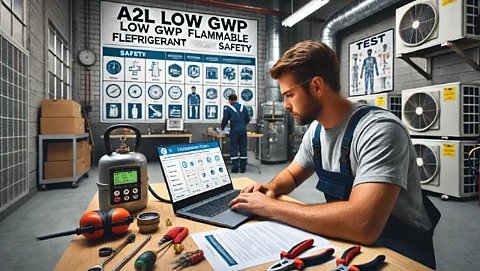

As environmental regulations shift and HVAC technologies evolve, technicians and contractors must keep pace with new industry standards. One of the most significant changes in recent years is the move toward low-global warming potential refrigerants—specifically, A2L classified refrigerants, which are mildly flammable but significantly better for the environment than many of their predecessors.
With the global phase-down of high-GWP hydrofluorocarbons, A2L refrigerants are quickly becoming the industry standard. This shift also brings a new emphasis on safety training and certification. If you're preparing for the A2L Low GWP Flammable Refrigerant Safety Test, understanding the core principles behind this class of refrigerants is essential—not only for passing the exam but also for maintaining safety in the field.
Refrigerants are classified based on two criteria: toxicity and flammability. The American Society of Heating, Refrigerating and Air-Conditioning Engineers (ASHRAE) uses a two-part classification system:
A or B: Indicates toxicity (A = lower toxicity, B = higher toxicity).
1, 2L, 2, or 3: Indicates flammability (1 = non-flammable, 3 = highly flammable).
A2L refrigerants fall under the “lower toxicity” and “mildly flammable” category. The “L” in 2L signifies that the refrigerant has a low burning velocity, making it less likely to sustain combustion under typical conditions.
The transition to A2L refrigerants is part of a larger international effort to combat climate change. Programs like the Kigali Amendment to the Montreal Protocol and domestic regulations such as the American Innovation and Manufacturing (AIM) Act in the U.S. aim to reduce greenhouse gas emissions by limiting the use of high-GWP refrigerants.
The A2L Low GWP Flammable Refrigerant Safety Test assesses a technician's knowledge of:
Safe handling and transportation of A2L refrigerants
Installation procedures and codes
Leak detection protocols
Personal protective equipment (PPE)
Emergency response and mitigation
Passing this test often requires more than just reading a manual. Real understanding comes from interactive learning, hands-on experience, and practicing with realistic assessment tools such as an a2l practice test.
A2Ls, although only mildly flammable, can still pose ignition risks in enclosed spaces. Proper ventilation is crucial during installation, servicing, and recovery processes to prevent the accumulation of refrigerant vapors.
Technicians must be cautious around potential ignition sources such as:
Open flames
Hot surfaces
Electrical arcs
Even though A2L refrigerants have low burning velocities, under the right concentration and conditions, they can still ignite.
Traditional soap-bubble or halide leak detection methods may not suffice. Use electronic leak detectors rated for A2L refrigerants, and ensure that detection devices comply with industry standards.
Charging systems with A2L refrigerants may require different procedures than legacy systems. Use tools that are rated for flammable refrigerants, and never mix A2L refrigerants with other refrigerant types.
While theory is critical, practice makes the difference between passing and failing. An a2l practice test provides a realistic snapshot of what to expect and how prepared you really are.
Timed questions mimic the actual pressure of the certification environment.
By reviewing incorrect answers, you can focus on specific areas like ignition thresholds, ventilation strategies, or system design standards.
The more you practice, the less likely you are to be caught off guard.
Familiarity with question formats and test flow calms nerves and improves performance.
Make sure your a2l practice test comes from a credible source that reflects the latest industry standards and regulatory updates.
As more systems transition to low-GWP refrigerants, certified professionals will be in high demand. Earning your A2L certification can:
Enhance job security
Position you as a leader in sustainability
Increase earning potential
Open doors to specialized contracts and federal projects
In some regions, municipalities or clients may require certification before technicians are allowed to install or maintain systems containing A2L refrigerants.
As the industry embraces greener technologies, the A2L Low GWP Flammable Refrigerant Safety Test becomes more than just another box to check. It represents a shift in how technicians approach their craft—with safety, responsibility, and sustainability at the forefront.
Whether you're a new technician or a seasoned pro looking to update your skills, preparing with the right study materials and a thorough a2l practice test will set you up for success. The transition to A2Ls is not just a regulatory demand—it's an opportunity to lead the way in safe, efficient, and eco-conscious cooling solutions.
